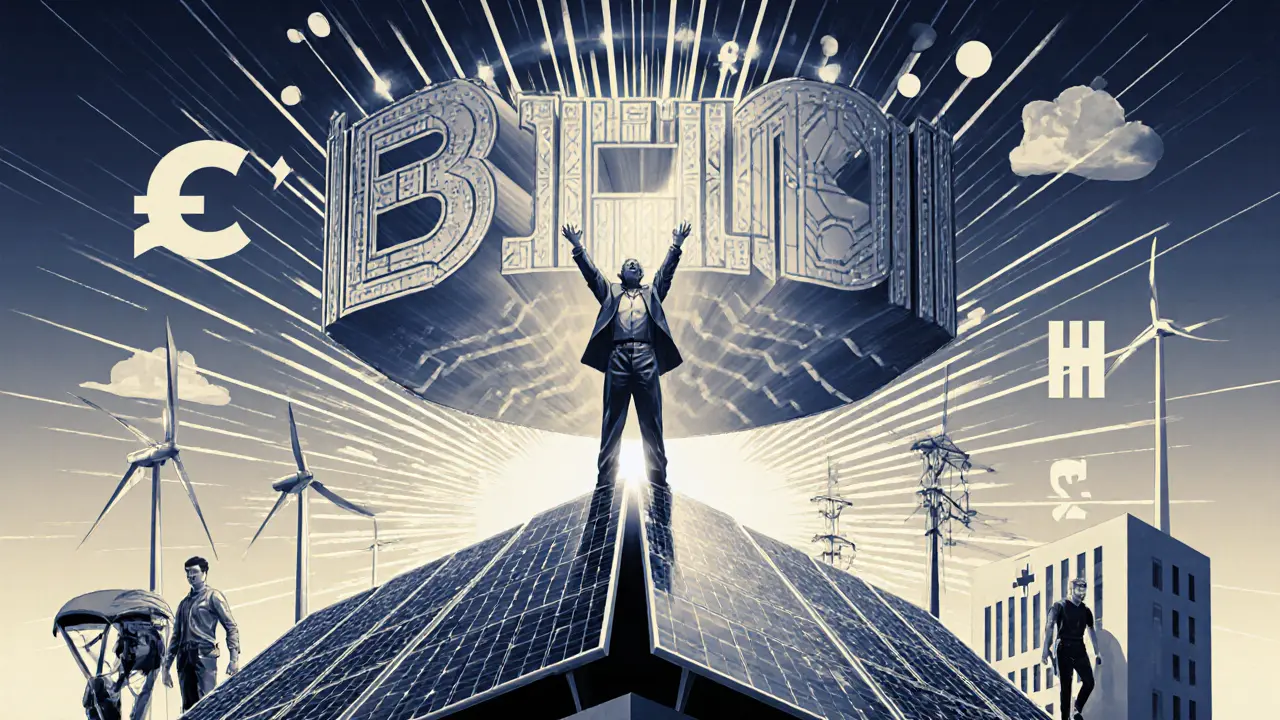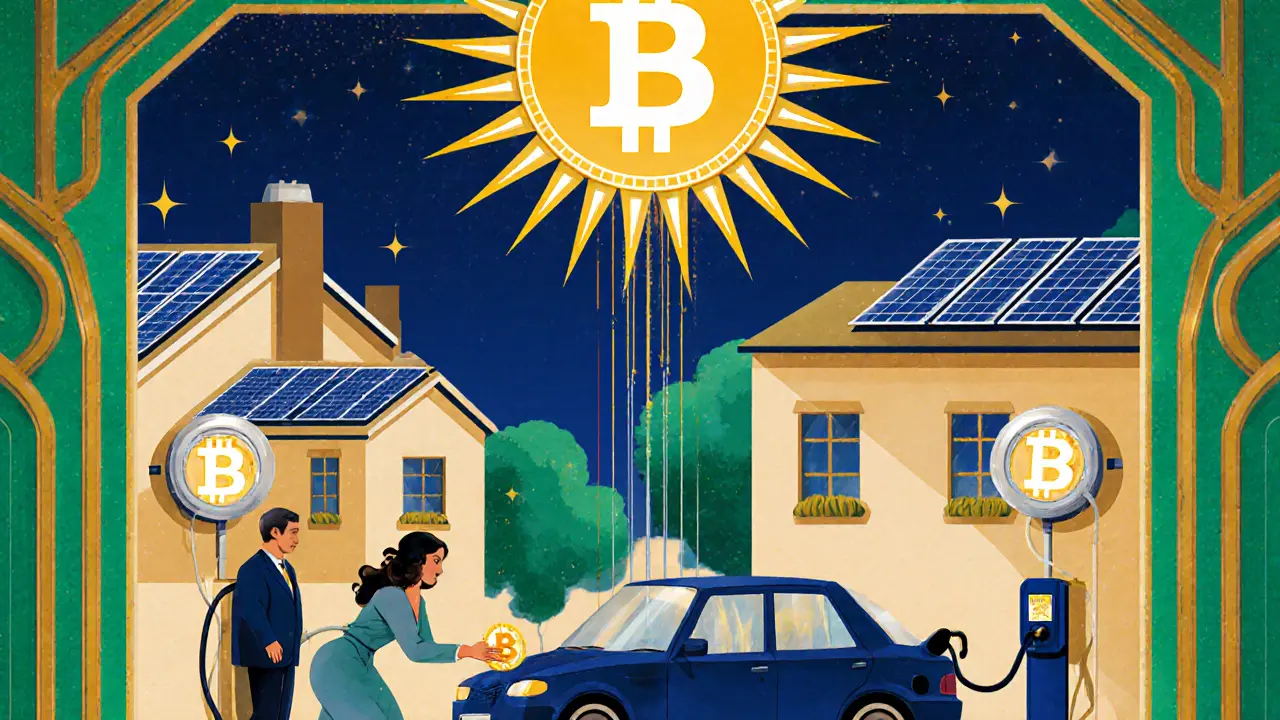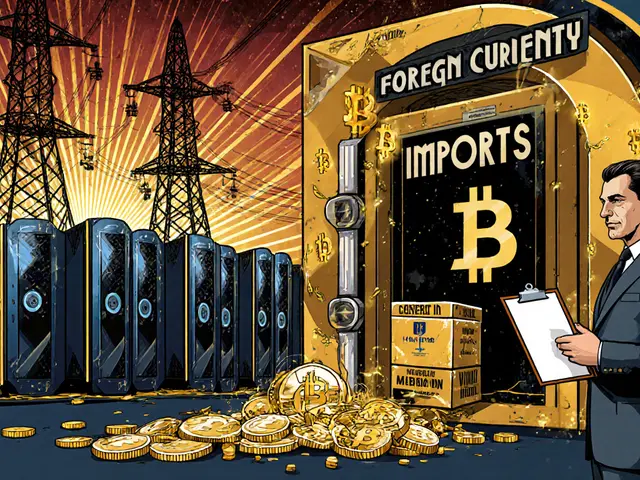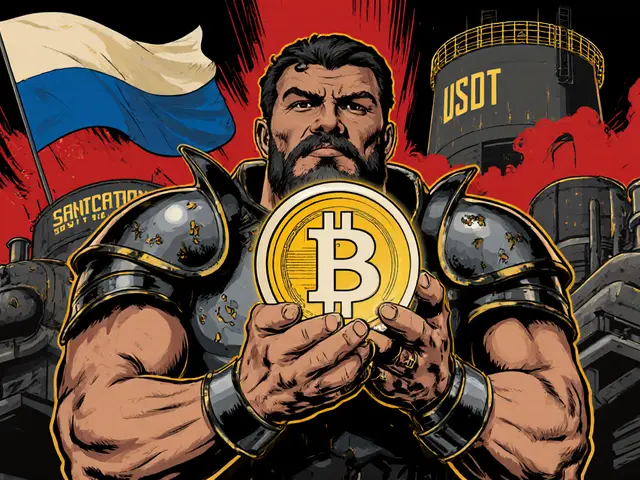Energy Trading Earnings Calculator
Calculate Your Solar Earnings
Estimate potential monthly income from selling excess solar power through blockchain energy trading
Estimated Monthly Earnings
Based on typical self-consumption rates (30% used on-site, 70% surplus for trading)
What this means for you:
$0.00 monthly income from your solar surplus. This could cover your monthly grocery bill.
$0.00 monthly income. This could cover your electric vehicle charging costs.
Real-world note: Actual earnings depend on local energy demand, network participation, and blockchain platform fees. See how it works
Imagine your solar panels don’t just power your home-they also earn you money by selling extra electricity to your neighbor. No utility company in between. No complicated bills. Just a quick, automatic deal, recorded forever on a digital ledger. That’s blockchain energy trading-and it’s already happening in real neighborhoods across the world.
Cutting Out the Middlemen
Traditional energy systems are built like old highways: power plants generate electricity, it travels hundreds of miles through transmission lines, gets stepped down by substations, and finally reaches your home through a monopoly utility. Every step adds cost. Billing departments. Regulatory fees. Grid maintenance. Profit margins. All of it gets tacked onto your monthly bill. Blockchain energy trading removes those layers. Instead of buying power from a distant plant, you buy it directly from the person next door who has solar panels. Or from the community wind farm down the street. Smart contracts-self-executing code on the blockchain-handle everything. When your neighbor produces more solar power than they need, the system automatically offers it at a fair price. If you’re using more electricity than usual, your device checks nearby sources and buys the cheapest clean power available. No brokers. No paperwork. No delays. This isn’t theory. In Brooklyn, the TransActive Grid project lets residents trade solar power peer-to-peer using blockchain. In Australia, the Power Ledger platform lets households sell excess energy to others in real time. The result? Lower costs for buyers, higher returns for producers, and less money wasted on middlemen.Transparency You Can Trust
Ever wonder who’s really setting your electricity prices? Or if your utility is hiding behind “market fluctuations” to raise rates? With blockchain, every single energy transaction is recorded on a public, tamper-proof ledger. Once a trade happens-say, 2 kWh from Sarah’s rooftop to Mark’s house-it’s stamped with a timestamp, location, and price. That record can’t be erased, changed, or hidden. This level of transparency builds trust. Prosumers (people who both produce and consume energy) know they’ll get paid fairly. Buyers know they’re getting real renewable power-not just green-washed claims. Regulators can audit trades instantly. And because the data is distributed across hundreds of nodes, there’s no single point where someone can manipulate prices or delete records. In Germany, pilot programs using blockchain have shown that consumers are 47% more likely to trust their energy source when they can see exactly where it came from and who sold it. That’s not marketing. That’s proof.Real-Time Matching, Zero Waste
Renewable energy is unpredictable. The sun doesn’t shine all day. The wind doesn’t blow on schedule. That’s why so much clean power gets wasted-often called “curtailment.” Utilities shut down wind turbines or solar arrays because the grid can’t handle the surplus. Blockchain fixes that by matching supply and demand in real time. When your neighbor’s solar panels produce 10% more than they need at noon, the system doesn’t waste it. It finds someone nearby who’s running their dishwasher or charging their EV-and completes the trade automatically. No waiting for grid operators to approve it. No delays. No loss. In South Australia, a blockchain pilot reduced curtailment by 32% in just six months. That’s thousands of kilowatt-hours of clean energy saved from being thrown away. That’s more power for homes, businesses, and electric vehicles-all without building a single new power plant.
Small Producers, Big Opportunities
Before blockchain, if you installed solar panels on your house, your options were limited: sell excess back to the utility at a low, fixed rate-or just let it go to waste. Large energy companies controlled the market. Minimum transaction sizes, complex contracts, and bureaucratic hurdles kept small players out. Blockchain changed that. Now, you can sell 0.5 kWh to someone across the street. No minimum. No middleman. No waiting weeks for a check. The system handles microtransactions effortlessly. A homeowner with a small wind turbine can earn $15 a month from neighbors. A community garden with rooftop solar can pool its output and sell it as a group. In rural Kenya, blockchain-based microgrids are letting villages generate, store, and trade their own solar power. Families who once relied on kerosene lamps now pay less for electricity-and even earn income by selling surplus. This isn’t charity. It’s market access, democratized.Stronger, Smarter Grids
Centralized grids are fragile. One storm, one transformer failure, one cyberattack-and entire neighborhoods lose power. Blockchain energy networks are the opposite: distributed, resilient, and self-healing. Because power flows locally-between homes, businesses, and microgrids-the system doesn’t depend on one long, vulnerable line. If a part of the grid fails, energy can reroute automatically through other nodes. Smart contracts can prioritize critical loads: hospitals, emergency services, water pumps. And because every device on the network communicates in real time, the system balances supply and demand without waiting for a central command center. In Puerto Rico, after Hurricane Maria, communities with blockchain-enabled microgrids restored power faster than the main grid. They didn’t wait for outside help. They powered themselves.Privacy Without Sacrifice
Utilities used to track your energy use in granular detail-when you turned on the AC, when you left for work, even when you showered. That data was stored in one place, vulnerable to breaches and misuse. Blockchain gives you control. You choose what data to share and with whom. Your energy consumption patterns are encrypted and stored across the network, not in a single company’s server. You can still see your usage on your phone app, but no one else can access your private habits unless you allow it. In the EU, pilot projects have shown that users feel 63% more secure about their energy data when it’s managed through blockchain instead of traditional utility systems.
Empowering Communities
This isn’t just about technology. It’s about power-real power. The kind that keeps money circulating locally instead of flowing out to distant corporate headquarters. When your neighbor buys power from your solar panels, that money stays in your town. It pays your local electrician, supports your community co-op, funds a school project. It builds economic resilience. In Sweden, a blockchain energy project in the town of Växjö created a local energy currency. Residents earned tokens for producing clean power, which they could spend at local businesses. The result? A 22% increase in renewable adoption and stronger community ties.Greener Future, Faster
The planet doesn’t have time for slow transitions. We need to replace fossil fuels now. Blockchain accelerates that shift. By making renewable energy trading easy, fair, and profitable, it removes the biggest barrier: economics. People invest in solar panels not just to be green-but because they can make money from them. Businesses install wind turbines because they can sell excess power to nearby factories at a profit. A 2024 study by the International Renewable Energy Agency found that blockchain-enabled peer-to-peer trading could increase global renewable adoption by up to 18% in the next five years-just by making it easier for ordinary people to participate.It’s Not Perfect-But It’s Progress
Blockchain energy trading isn’t a magic fix. It needs smart regulation. It needs reliable internet. It needs standardization across platforms. Some early systems have struggled with scalability or user adoption. But the direction is clear. The technology works. The benefits are real. And the momentum is growing. From Brooklyn to Bali, people are taking control of their energy. They’re cutting costs. They’re reducing waste. They’re building cleaner, stronger communities. You don’t need to be a tech expert to benefit. You just need to be part of the system.How does blockchain energy trading actually work?
It uses a decentralized digital ledger to record every energy transaction between producers and consumers. Smart contracts automatically execute trades when conditions are met-like when solar panels produce extra power and a nearby home needs it. Payments happen instantly in digital currency or credits, and every trade is permanently recorded, transparent, and tamper-proof.
Can I sell my solar power with blockchain if I’m not tech-savvy?
Yes. Most platforms offer simple mobile apps that show you how much power you’re producing, who’s buying it, and how much you’re earning. You don’t need to understand blockchain-you just need to connect your solar system to a compatible meter and app. The tech handles the rest.
Is blockchain energy trading legal?
In many countries, yes. The EU, Australia, the U.S., and Japan have active pilot programs and regulatory frameworks allowing peer-to-peer energy trading. Some regions still require utilities to act as intermediaries, but laws are changing fast. Always check local regulations, but the trend is toward legalization.
How much money can I save or earn?
It depends on your location, energy production, and local demand. In pilot programs, homeowners with solar panels have earned between $10 and $50 extra per month by selling surplus power. Buyers often pay 10-30% less than utility rates. Over time, this can cut energy bills by up to 40% for households in active peer-to-peer markets.
Do I need special equipment to join?
You need a smart meter that can communicate with the blockchain network and a compatible energy management system. Most modern solar installations can be retrofitted with these devices. Some platforms offer bundled hardware and software packages for under $500, often with financing options.
What happens if the internet goes down?
Most systems are designed to keep generating and using power even without internet. The blockchain records transactions when connectivity returns. In offline mode, local energy flow continues as normal-just without real-time trading. Once the network is back, pending trades are processed automatically.
Is blockchain energy trading better than traditional net metering?
It’s different-and often better. Net metering lets you get credit from your utility for excess power, but the rate is usually low and controlled by the utility. Blockchain lets you sell directly to neighbors at market rates, often higher. You’re not dependent on one company’s policies. You’re part of a dynamic, local market.
Can apartment renters participate?
Yes. Some platforms allow renters to buy clean power from community solar projects or shared microgrids. Others offer virtual credits based on energy purchased from nearby producers-even if you don’t have panels yourself. You don’t need to own your roof to benefit.
What’s the biggest barrier to adoption?
Regulation and awareness. Many utility companies still hold monopolies and resist change. And most people don’t know this option exists. But as more communities launch pilot programs and see lower bills and cleaner power, adoption is growing fast.
Will this replace the main power grid?
No-not entirely. But it will make the grid stronger, smarter, and less dependent on fossil fuels. The main grid will still handle large-scale power and backup needs. Blockchain trading will handle local, real-time, clean energy exchanges. Together, they create a more resilient, efficient system.




andrew seeby
November 4, 2025 AT 02:38bro this is wild 🤯 i just got solar panels last month and didn’t even know i could sell extra power to my neighbor. thought i was just saving on my bill. now i’m checking if my meter’s compatible lol
Noah Roelofsn
November 4, 2025 AT 21:30Blockchain energy trading isn’t just a tech novelty-it’s a structural reformation of how we conceptualize utility. The elimination of intermediaries doesn’t merely reduce costs; it redistributes agency. Every microtransaction becomes a node of local sovereignty. Smart contracts execute with cryptographic precision, turning surplus energy into liquid capital without bureaucratic friction. This isn’t distributed ledger technology-it’s distributed democracy. The grid isn’t being upgraded; it’s being reimagined as a peer-to-peer ecosystem where value flows horizontally, not hierarchically. And yes, it’s already working in Brooklyn, Australia, and rural Kenya-not as a pilot, but as a lived reality for thousands.
Sierra Rustami
November 5, 2025 AT 13:45USA invented the grid. Now some hippie tech bros want to replace it with blockchain? We don’t need crypto energy-we need American-made power plants and real infrastructure. This is just another Silicon Valley fantasy.
Glen Meyer
November 6, 2025 AT 22:17Oh great, so now my neighbor’s solar panels are gonna charge me more because they’re ‘earning’ from me? Sounds like socialism with extra steps. Who’s gonna pay when the internet goes down and my AC dies? Some guy in a hoodie with a laptop?
Pranjali Dattatraya Upadhye
November 6, 2025 AT 23:00Wow, this is so beautiful!! I live in India, and our village has a tiny solar microgrid-just 8 panels on the school roof-and we’ve been trading power manually with neighbors using paper logs. Imagine if we could do this on blockchain? No more arguments over who used too much, no more delays in payments… it’s like magic, but real!! I’m already researching how to set this up for our community!!
Abelard Rocker
November 7, 2025 AT 16:42Let’s be real-this isn’t about energy. It’s about control. Who owns the sun? Who owns the wind? Who owns the right to sell the air you breathe? Blockchain energy trading is the ultimate neoliberal fantasy wrapped in a blockchain-shaped blanket. It’s not ‘democratizing’ anything-it’s turning your backyard into a crypto-mining farm for the 1%. The ‘transparency’? It’s just surveillance with a better PR team. And don’t get me started on ‘smart contracts’-those are just legally unenforceable code written by engineers who think ‘if-then’ statements can replace human empathy. Meanwhile, the grid’s still crumbling, and the rich are still hoarding the sun. This isn’t progress-it’s capitalism with a glow-up.
Hope Aubrey
November 8, 2025 AT 17:10Okay but like… have y’all seen the energy pricing volatility in these pilot programs? I work in energy analytics and the data’s messy. Sure, you save 10-30% sometimes-but when demand spikes and 50 people all try to buy power at once? The smart contracts go haywire. Also, ‘microtransactions’ sound cute until you realize you’re paying 3 cents per kWh with 0.5 cent network fees. That’s not savings-that’s friction. And don’t even get me started on the carbon footprint of maintaining all those nodes. Green tech isn’t green if it’s powered by GPUs running 24/7.
Kyung-Ran Koh
November 8, 2025 AT 21:11This is exactly the kind of innovation we need to empower marginalized communities. I’ve seen how traditional utility systems leave low-income households stranded-especially during outages. Blockchain microgrids don’t just offer affordability; they offer dignity. When people can see exactly where their power comes from, and earn from it, it changes their relationship with energy. And yes, the tech needs refinement-but the intent? Pure. Let’s not dismiss this because it’s new. Let’s help it grow. 🌱⚡
Ryan McCarthy
November 10, 2025 AT 09:12What’s amazing to me is how this bridges generations. My 70-year-old neighbor just joined a local blockchain energy group. She didn’t know what a blockchain was-but she got a simple app that shows her how much she earned last week from her solar panels. Now she’s buying groceries with her energy credits. That’s not just tech. That’s community. And it’s happening quietly, everywhere. No hype. Just real people making real change. Keep it simple. Keep it local. Keep it fair.
Christopher Evans
November 10, 2025 AT 13:52The regulatory landscape remains a significant obstacle. While technical feasibility has been demonstrated in multiple jurisdictions, legal recognition of peer-to-peer energy transactions as a valid commercial activity is inconsistent. Utility commissions retain authority over grid interconnection standards, tariff structures, and metering protocols. Until federal and state-level frameworks align with decentralized energy models, scalability will remain constrained. Continued pilot programs are essential, but legislative action-not technological optimism-is the true catalyst for adoption.